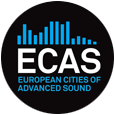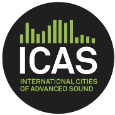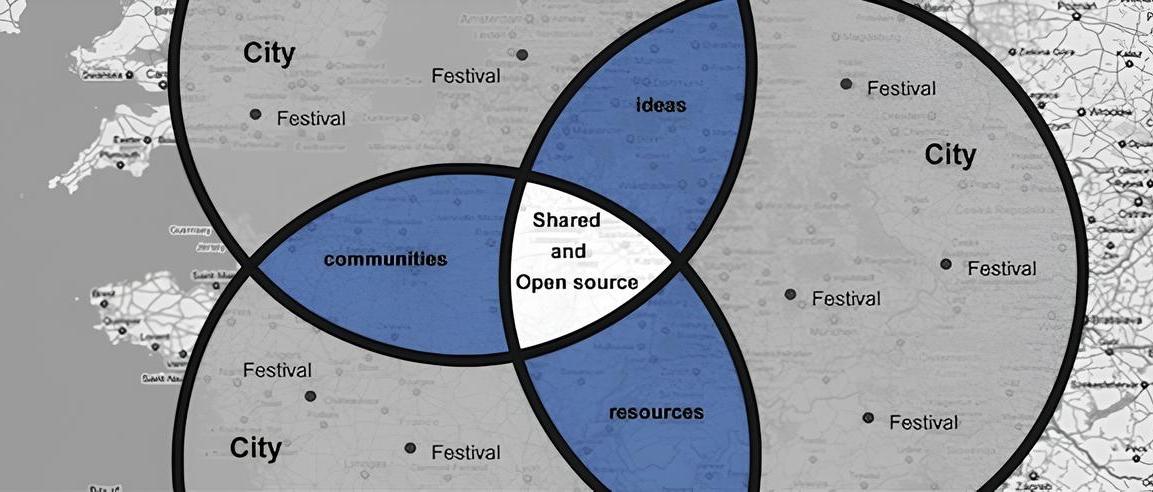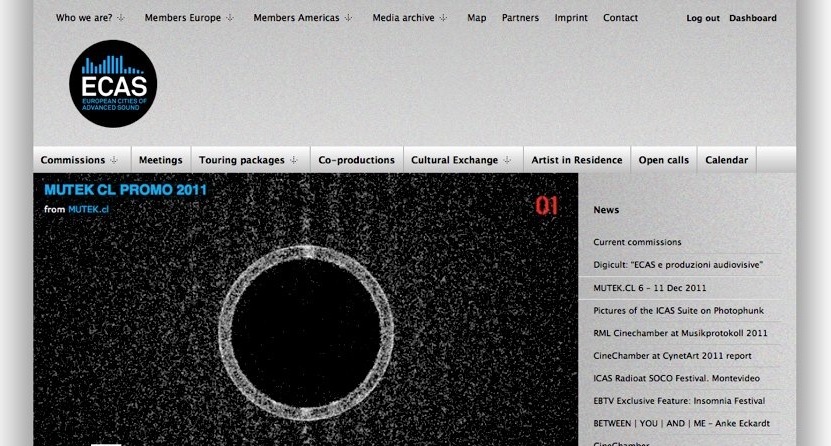



European Cities of Advanced Sound and related arts is a network of independent non-profit organisations across Europe, all dedicated to advancing sound cultures, music and related arts.
All members of ECAS have spent years crafting unique festivals and events, each with its own identity grounded in strong local connections and context.
The ICAS network emerged from the ECAS – European Cities of Advanced Sound network, when the ideas and potential for collaboration provided by the ECAS framework sparked interest from international partners. The ICAS network was thus conceptualised by founding members of ECAS and likeminded festivals in Europe, North and South America during Montreal’s MUTEK festival in 2009.
In 2010, ECAS officially launched Networking Tomorrow’s Art for an Unknown Future, a 5-year project sponsored by the European Commission’s Programme Culture dedicated to exploring the future of art and culture and the infrastructures that support them. Zooming in on the social and political role of music and the arts in cultural and community life, the project aims to identify tools for independent cultural production, support creative innovation and artist mobility, and engage diverse audiences in the exploration of new cultural forms and technologies. Initiatives within the project strive to propose new methods of collaboration for cultural workers, and have included the commission of artistic works, artist residencies, and international conferences and colloquia.
Using a palette of transdisciplinary approaches, ICAS member organisations reflect on the aesthetic and societal agency of contemporary sound creation in regard to transformation processes induced by digital technology, and actively engage in building bridges between art disciplines, cultural fields, scenes, and genres.
Its goal is also to support members in their activities to develop and promote independent music and sound creation within their specific localities.
Activities within events and festivals organised by ICAS members include concerts, performances, commissioned work, exhibitions, participatory projects, educational workshops, conferences, presentations, panel discussions, publications, and the curation of informal spaces for knowledge-sharing within and among fields.
ICAS serves as an interface to intensify dialogue between its members and decision makers in cultural, political, and economic fields, propose alternative criteria for measuring success and regulating exchange, and increase public awareness concerning the issues addressed by ICAS and its member organisations.
The ECAS Network currently consists of nine co-organisers and 18 EU and11 non-EU affiliated partners from 14 European and eight non-European countries. Each if this network members currently produces and maintains an annual not-for-profit music and related arts organisation and festival.
As a collective network, this group has access to an immense amount of experience, knowledge and contacts in East and Western Europe, Asia, the Middle East and the Americas.
A wealth of artists, creative business initiatives, ideas, projects, funding know-how and administrative experience exist in this network, that when combined will create a formidable cultural resource for ECAS members, partners, institutions and cultural workers alike.
The formation of the network will provide access to solutions and ideas for many of the problems faced by these often idealistic not-for-profit organisations during their continued development.
Projects and productions being developed both by the ECAS project and independently by partners would be ‘pooled’ and shared by the group. Trans European sponsor networks and related creative business initiatives will be established, opening up a much larger arena for potential partnerships, both financial and creative, and without threatening the profile of individual events or compromising quality.
By formalising this network and through a commitment to sharing our experiences and knowledge, we will create a sustainable organisation that can offer support to all members and partners in an atmosphere of unity that also celebrates innovation and European diversity.
Aims
Framework of new cultural forms related to sound and new technologies.
Developing new technological tools.
Unity of members and art forms they represent.
Objectives
Commission and present inter-cultural artworks.
Citizen creativity and innovation.
Engagement methods.
Mobility of artists, audiences and professionals.
Artistic collaboration.
Build connections and consolidate ECAS networks.
Background
Adoption of digital technologies.
Local and global.
User generated content.
Real time information sharing.
Supporting and nurturing cultural connections.
Audience participation.
Activity outlines and deliverables
Artistic co-commissions and curatorial projects.
Audience development and engagement initiatives.
Festivals and events as living laboratories
Playgrounds or experimental spaces.
Present and evaluate with a live audience new technology prototypes, new cultural forms, new modes of audience engagement.
Broaden research and engagement methods.
Art, sound and the everyday
The City is increasingly a focus, as urban spaces draw together different communities and forms of media and technology.
Digital technologies are changing the city
Cultural events, which respond to the urban context.
Site specific artworks in each city responding to the specific local context and engaging local communities.
Sound in public space will articulate the ways in which artists and sound practitioners are designing and using sound in the public domain, so that current trends and practices can be examined, compared and contrasted.
Trans-national level.
Bridging different cultural sectors and different media.
Creative dialog between diverse migrant communities, minority music.
Audience
Presenting the work in a special context/ public space.
Experimenting with venues and formats.
Using online and mobile media that allows the audience to shape projects and become involved in the creative process.
Cultural and environmental relevance
Wider societal impact.
The concept of “digital public space”
Engaging large audiences in high quality cultural events in the public realm
Showcasing new approaches to public space.
Tools for Unknown Future
Sustainability and legacy.
Developing a set of tools for a members and other cultural institutions
Establish sustainable ECAS network
Applied and theoretical knowledge into tool-kit
Form of a set of resources for cultural production and event organization, focusing upon the specific insights and expertise of the ECAS members and their partners.
The tools will be in the form of online and printed resource.
1 Database and forum for international funding opportunities.
2 Archive for new art forms.
3 Database for emerging artists.
4 Audiences/ Toolkits.
5 Online forum for audiences and followers of advanced sound and related arts.
Ideas
Look back on what has been developed so far.
Toolkit will help cultural workers, artists and the general public in their quest for empowerment and inter-connectivity.
New working methods, new funding instruments.
Residences.
Workshops.
Trainees and internships.
Meetings.


Experimenting new forms, models and methods.
Engaging audiences.
Bridging sectors and media.
Enabling citizen innovation.
Extending to the everyday
Measuring the impact
*with emphasis placed on the importance of digital culture and the arts.
Municipalities and policy makers
Encouraging people from different backgrounds to collaborate and improve the city environment with new cultural forms related to sound and new technologies.
Bridging different cultural sectors, gap between art and community to inspire positive social change.


This work programme has been funded with support from the European Commission.

Hear, interacting with end-users to learn the E.C.A.S. Network situation, gathering stories and ideas, understanding how community structured.
Making sense of data.
Identifying patterns.
Defining opportunities.
Create, design prototype solutions to test with the end-users.
Synthesis, brainstorming, prototyping, and feedback.
Create opportunity areas.
Deliver, the third and final phase covers implementation, creating sustainability models, and measuring and monitoring feedback and performance.
Identify required capabilities.
Create model for financial sustainability.
Develop an innovation pipeline.
Plan pilots and measure impact.
1. Core group definition, pilot projects collection, supporting platform design (year 1).
An initial “core group” of partners (inside and outside ECAS) is defined.
A collection of framework projects is realised (it could be a short list of 10-20 projects).
A first pilot on 3 framework projects is conducted with the aim to analysed them in depth (out of the list of 10-20)
A template is designed on the basis of the results that will come from the pilot.
Web platform to facilitate the exchange of experiences between the partners, and between the selected projects main actors, is designed.
A Workshop is organised with representatives of the pilot projects (sharing experiences; comparing approaches; further investigations; action plan for further collaboration and research online.
2. Projects collection and platform fine-tuning (year 2)
A collection of a second, wider set of framework projects is realised.
The collected cases are clustered and common characteristics are focalised.
The supporting platform is up-graded.
3. Scenario building and platform use extension (year 3)
On the basis of the previous 2 years of experiences, different scenarios are built and visualised.
The up-graded supporting platform is opened to other interested actors and a variety of other interested stakeholders.
4. Projects and scenarios communication (end of year 3).
A publication presenting projects, clusters and scenarios is prepared (using different contributions collected through the platform).
5. Working group meetings / Collaboration (all along 3 years)
Three Task group meetings will be organised during each of the project year.


